Playback speed:
In the dynamic world of public relations, each year brings new opportunities but also challenges. To continually maintain a positive image in the public eye, a brand must develop a solid strategy through multiple paid and unpaid channels—social media, press, in-person communication, etc. PR professionals have to skillfully combine compelling storytelling and crisis management to build a favorable reputation.
If you’re curious to know more about PR statistics in 2024, we’ve handpicked a list of the most interesting numbers and metrics. It will serve as a guide to the depths of PR data and enlighten the way for everyone who dares to embark on such a journey. You’re all invited.
So let’s begin!
Must-Know PR Stats and Facts in 2024 (Key Findings)
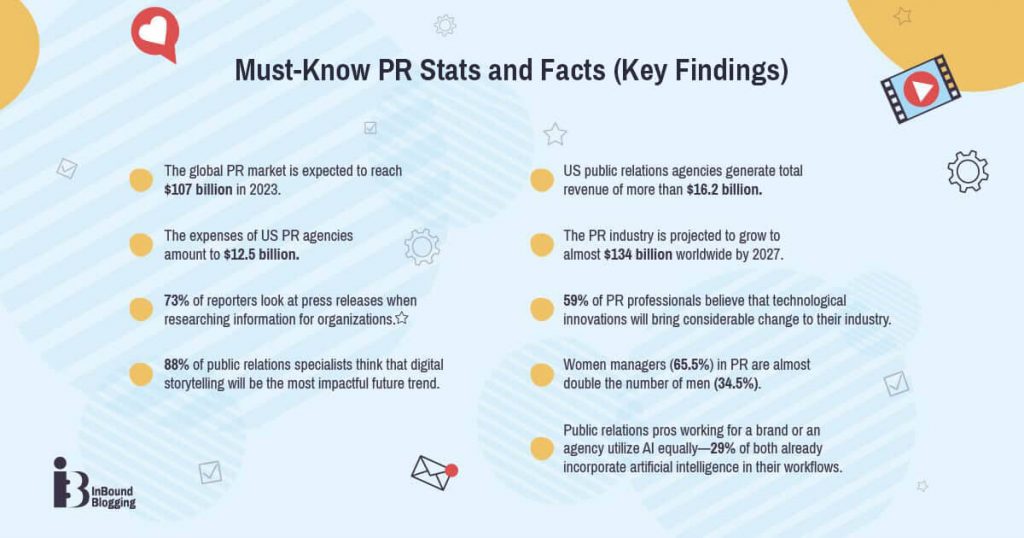
- The global PR market size is expected to reach $107 billion in 2023.
- US public relations agencies generate total revenue of more than $16.2 billion.
- The expenses of US PR agencies amount to $12.5 billion.
- The PR industry is projected to grow to almost $134 billion worldwide by 2027.
- 73% of reporters look at press releases when researching information for organizations.
- 59% of PR professionals believe that technological innovations will bring considerable change to their industry.
- 88% of public relations specialists think that digital storytelling will be the most impactful future trend.
- Women managers (65.5%) in PR are almost double the number of men (34.5%).
- Public relations pros working for a brand or an agency utilize AI equally—29% of both already incorporate artificial intelligence in their workflows.
General PR Industry Statistics
In the landscape of PR, it’s important to understand the general industry stats to keep up with trends and improve strategies.
Let’s dive into some numbers that paint a picture of the PR industry’s state:
- 58% of adult Americans said they have at least some trust in national news. For local news, this percentage equals 75%, while social media earned only 27%. Since PR experts are professional storytellers, this stat provides insightful information about the most trusted media channel among US residents.
- In 2021, 46% of Chief Communication Officers (CCOs) reported directly to the Chief Executive Officer (CEO). That’s a 12% increase since 2014 when that figure was only 34%. CCOs are the top-level PR professionals of the company responsible for all public communications. The increase speaks of the rising importance of PR in company operations.
- The world PR industry is projected to grow by 6.6% in 2023, increasing from $100.4 billion in 2022 to $107 billion in 2023. If we fast forward to 2027, the predicted market size of the global PR industry will reach $133.8 billion.
- It’s predicted that jobs in public relations will grow by 9% between 2016 and 2026. This shows the increasing need for PR specialists.
- According to 59% of PR pros, technological advancement will bring significant change to the public relations industry.
- 54% of European communication professionals report that their company has been a victim of cyberattacks or data theft. Moreover, for about 40% of organizations, hacker attacks caused brand reputation damage. PR professionals are the people who handle crisis management in situations like this.
- Threat Intelligence is becoming an invaluable asset for PR experts in managing cyber crises. 54% of large companies in the US have incorporated security monitoring and analytics into their cybersecurity practices.
- Interestingly, 34% of US respondents don’t trust at all that their personal data is kept safe by social media companies. So the data safety issue is a pressing matter for both users and organizations.
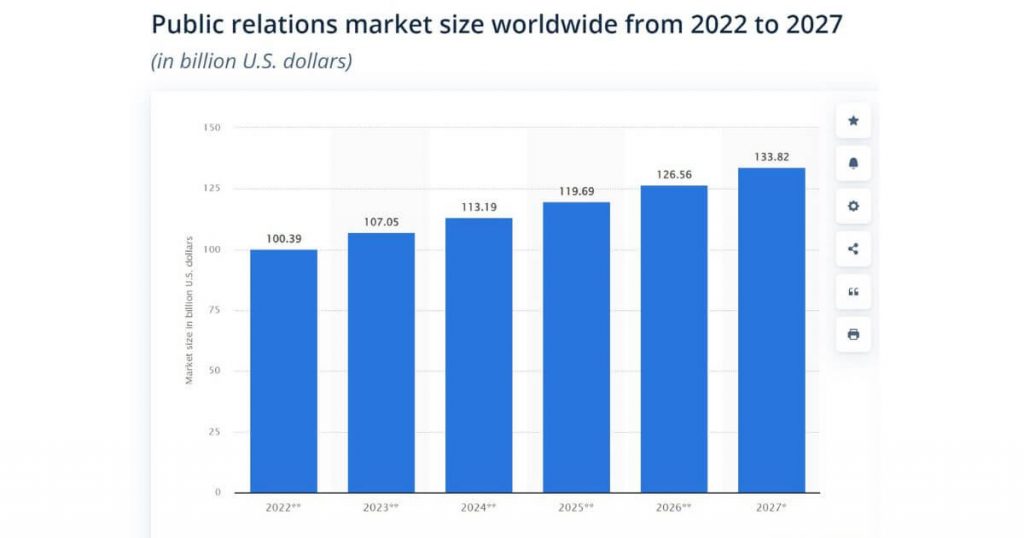
Image source: Statista
The PR facts below give us a glimpse into the industry at large, highlighting the most important tendencies.
| Fact | Description |
| Shift toward digital PR | As technology progresses, the PR industry is shifting toward digital platforms. In fact, digital PR statistics show a drastic increase in the use of social media and online press releases. |
| Challenges faced by PR experts | Many PR experts face challenges related to a lack of skills and resources and tight turnaround times. This underscores the need for continual optimization of tactics and staying up to date with industry trends. |
| Importance of data analysis in PR | Data analysis is increasingly crucial in PR. Businesses utilize statistical analysis to assess data correctly and acquire accurate information for future plans and strategies. |
PR Budgeting Statistics
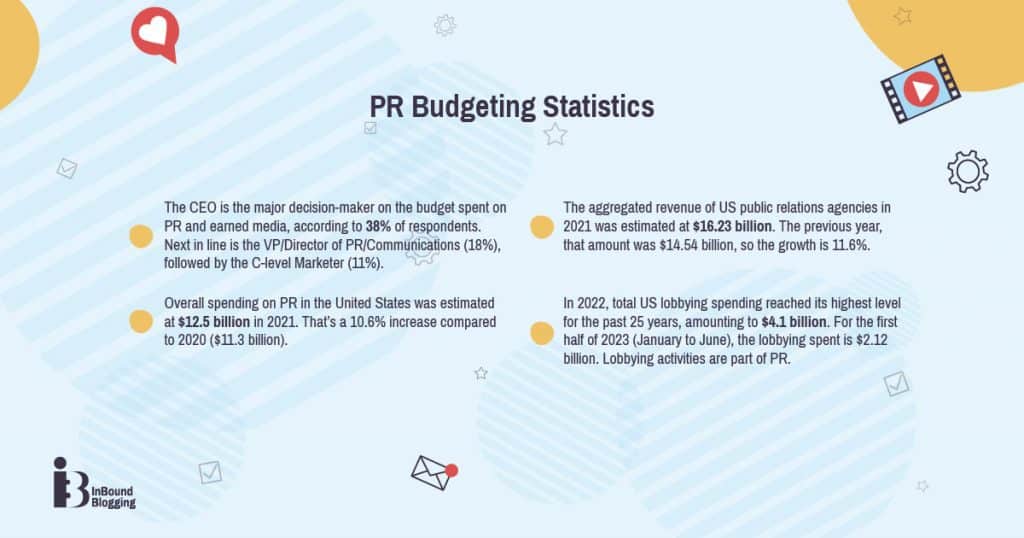
Companies spend different amounts on PR depending on their individual goals. However, investing in PR is much needed if a business wants to build and maintain a favorable public image.
Let’s take a look at the most significant PR budgeting stats:
- According to 38% of respondents, the CEO is the primary decision-maker on PR and earned media budgets. Next in line is the VP/Director of PR/Communications (18%), followed by the C-level Marketer (11%).
- Overall spending on PR in the United States was estimated at $12.5 billion in 2021. That’s a 10.6% increase compared to 2020 ($11.3 billion).
- The aggregated revenue of US public relations agencies in 2021 was estimated at $16.23 billion. The previous year, that amount was $14.54 billion, so the growth is 11.6%.
- In 2022, total US lobbying spending reached its highest level for the past 25 years, amounting to $4.1 billion. For the first half of 2023 (January to June), the total lobbying spending was $2.12 billion. Lobbying activities are part of PR.
US PR expenses in billions of dollars per year:

Image source: Statista
Areas PR invested in the most worldwide as of February 2023:
- Staff training and retention—16%
- Technology and media production—9%
- Creativity—7%
- Measurements and analytics—6%
US PR agency’s revenue by source in 2021:
- Full public relations services—$10.2 billion
- Lobbying—$2.3 billion
- Media relations—$982 million
- Media monitoring and analysis—$176 million
- All other operating revenue—$1.99 billion
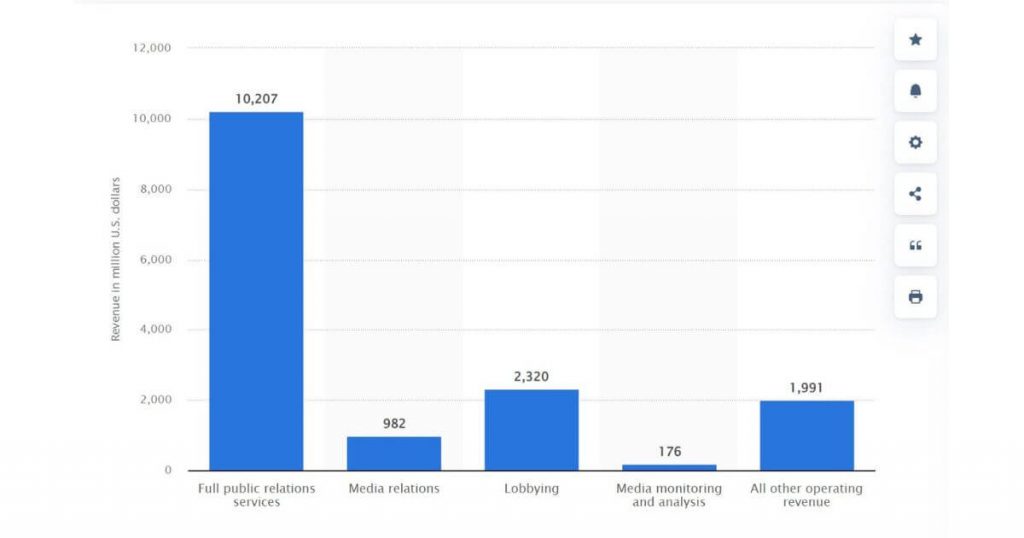
Image source: Statista
Top 3 major US PR firms by global net fees:
- Edelman—$1.08 billion
- Real Chemistry—$555 million
- Evoke—$368 million
PR Content Statistics
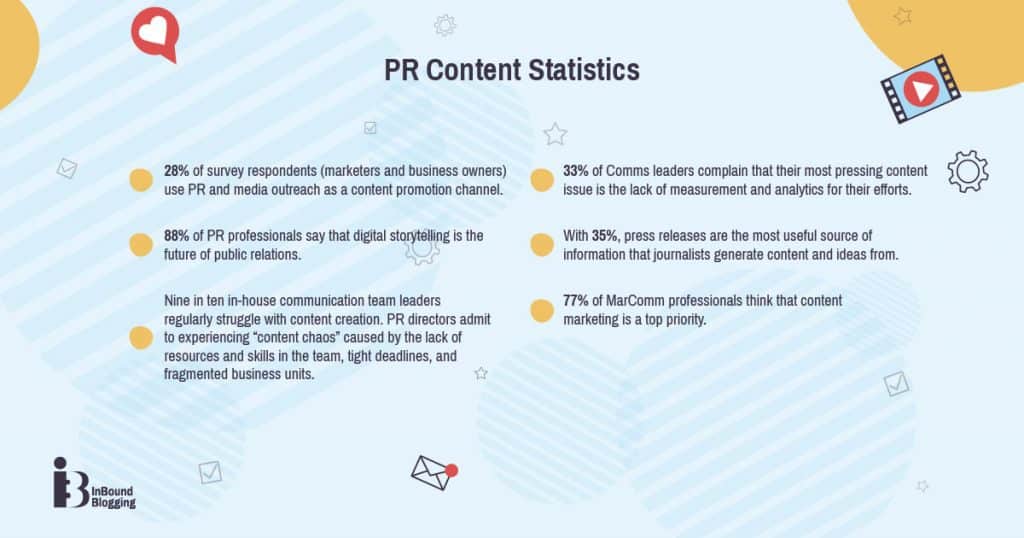
PR and content go hand in hand to achieve success but to what extent? Good examples of public relations content are press releases, pitches to journalists, or storytelling.
Let’s look at PR content stats and facts:
- 28% of survey respondents (marketers and business owners) use PR and media outreach as a content promotion channel.
- 88% of PR professionals say that digital storytelling is the future of public relations.
- Nine in ten in-house communication team leaders regularly struggle with content creation. PR directors admit to experiencing “content chaos” caused by the lack of resources and skills in the team, tight deadlines, and fragmented business units.
- 33% of Comms leaders complain that their most pressing content issue is the lack of measurement and analytics for their efforts.
- 77% of MarComm professionals think that content marketing is a top priority.
- With 35%, press releases are the most useful source of information that journalists generate content and ideas from.
The top 5 most useful sources for journalists for content or idea generation are:
- Press releases (35%)
- Industry experts (18%)
- Major newswires (14%)
- Company spokesperson (12%)
- Email pitches (9%)
PR Pitching and Press Release Statistics
Pitching to journalists is part of PR specialists’ responsibilities. It’s not that easy to capture reporters’ attention, especially for small businesses no one has heard of before. However, this tactic plays an essential role in the PR strategy.
- Press releases are the go-to resource for 73% of reporters when researching an organization.
- Press releases are the third most trusted information source for journalists, with 20%. Major newswires ranked first with 27%, while industry experts ranked second with 23%.
- 68% of journalists want to receive data, such as original research, trends, and market insights, from public relations professionals.
- Press releases with multimedia content receive six times more engagement than regular text ones.
- The best day to send a press release is Thursday as emails get the highest open rate of 27%. The second best is Tuesday with 19%. Mondays and Fridays are the worst choices. The majority of PR pros (53%) prefer pitching on Tuesday.
- The best time to send a press release is from 10 am to 2 pm as open rates rise to 45%. After that, they drop to 15%.
- The success rate of PR pitching is about 8%. This means that for every 100 pitches sent, only a handful will result in positive coverage or media attention.
- 56% of publishers would reject overly promotional pitches, while 48% would reject a boring one. These numbers may seem discouraging, but by analyzing real-life pitches and learning from them, you can gain valuable insights and increase your chances of securing media coverage.
- Concise pitches receive the highest response rate (8.3%) from journalists. This highlights the importance of being short and getting straight to the point when reaching out to the media.
- The average open rate for a cold email—a common method used in PR pitching—is about 44%. This shows that while not all recipients may be interested or responsive, there is still potential for engagement if your approach is well-crafted.
- Getting journalists to respond is the top PR concern, according to 53% of respondents.
- 89% of PR pros say that the most effective way to pitch journalists is through one-on-one emails. Twitter and mass email follow, both with 18%.
- 64% of reporters prefer to receive pitches in the morning. Evening pitches are widely unpopular as only 4% of journalists prefer them. Moreover, 85% of PR specialists say that it’s best to send pitches in the morning.
Currently, PR pros utilize AI mostly for:
- Crafting pitches (57%)
- Writing press releases (48%)
- Creating social media copy (48%)
- Researching (44%)
By understanding these PR pitching statistics and applying them to your strategies, you can improve outreach efforts and success rates in securing media coverage.
If you’re considering pitching to online media, click the link to read about the best HARO alternative platforms you can use.
PR Tools Statistics
By utilizing PR channels and tools, professionals streamline their workflow, monitor the media, and analyze the impact of their efforts.
Let’s investigate further:
- Email is the communication tool PR experts use the most.
- 34% of PR teams use social listening tools on a daily basis. Another 34% answered that it depends on the case. 18% use them weekly and only 7% use them monthly.
- 34% of public relations pros plan to explore generative AI in their workflow. 28% already use it.
- 68% of PR specialists store media lists on spreadsheets, while 64% use specialized PR software.
- Media databases are the most commonly used method for finding journalists to pitch to, leading with 83%. They are followed by Google search (59%), Personal contact list (50%), and Social media (48%).
- 53% of PR consultants plan to use LinkedIn more this year, while 25% stated they’ll use Facebook less. So Facebook is becoming less relevant.
- LinkedIn is the top social media platform that PR specialists include in their communication strategy, leading with 84%.
- 35% of communication professionals use project management software every day. However, 31% of respondents have never used such a tool.
- The most popular types of marketing software are email automation and web analytics platforms.
- The market value of public relations tools is expected to reach $14.79 billion in 2023. Compared to the previous year, there is over 10% growth. By 2030, that value is forecasted to top $29 billion.
- In 2022, the United States was responsible for over a quarter of the global PR tools market value, owning a 27.6% share. China’s share was 17%.
The top 4 most important metrics for PR success are:
- Number of stories placed
- Reach/impressions
- Key message pull-through
- Website impact
Statistics on PR Professionals
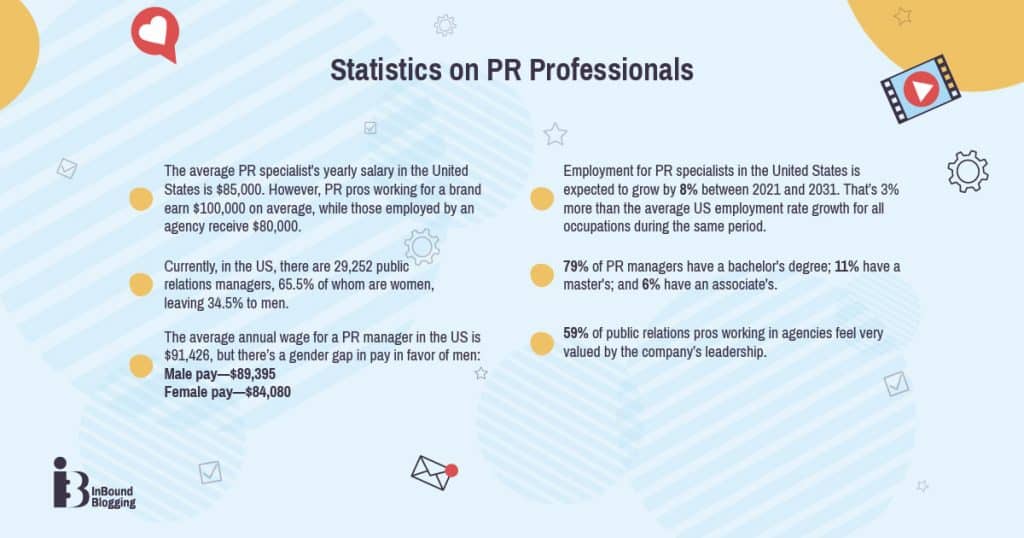
PR specialists are communication experts with diverse specialties and talents. They masterfully handle content and are great communicators of ideas and stories. Their role is interconnected with marketing, but public relations is more about building brand credibility, while marketers work toward generating sales.
Let’s see how these masters of communication are doing in the PR field:
- The average PR specialist’s yearly salary in the United States is $85,000. However, PR pros working for a brand earn $100,000 on average, while those employed by an agency receive $80,000.
- Currently, in the US, there are 29,252 public relations managers, 65.5% of whom are women, leaving 34.5% to men.
- The average annual wage for a PR manager in the US is $91,426, but there’s a gender gap in pay in favor of men:
- Male pay—$89,395
- Female pay—$84,080
- Employment for PR specialists in the United States is expected to grow by 8% between 2021 and 2031. That’s 3% more than the average US employment rate growth for all occupations during the same period.
- 79% of PR managers have a bachelor’s degree; 11% have a master’s; 6% have an associate’s.
- 59% of public relations pros working in agencies feel very valued by the company’s leadership.
Other PR Statistics
We’ve covered a lot of ground in this article, but there are still some key PR stats that you should know.
So here they are:
- 42% of public relations professionals say that they brief the executive team of their own or a client’s company every week.
- 88% of global consumers trust recommendations from people they know over any other channel. So word of mouth is not to be underestimated by brands when building a positive public image.
- 93% of PR specialists consider influencer marketing an important public relations tool. By partnering with the right influencers, companies can effectively build trust with potential customers.
- For 44% of PR respondents, the amount of time PR teams spend on internal communication is increasing. For 42%, it is the same.
- According to 85% of PR survey respondents, media relations is the primary function of their job. Thought leadership is the second priority with 51%, followed by media measurement and reporting with 47%.
The Future of PR and Industry Trends
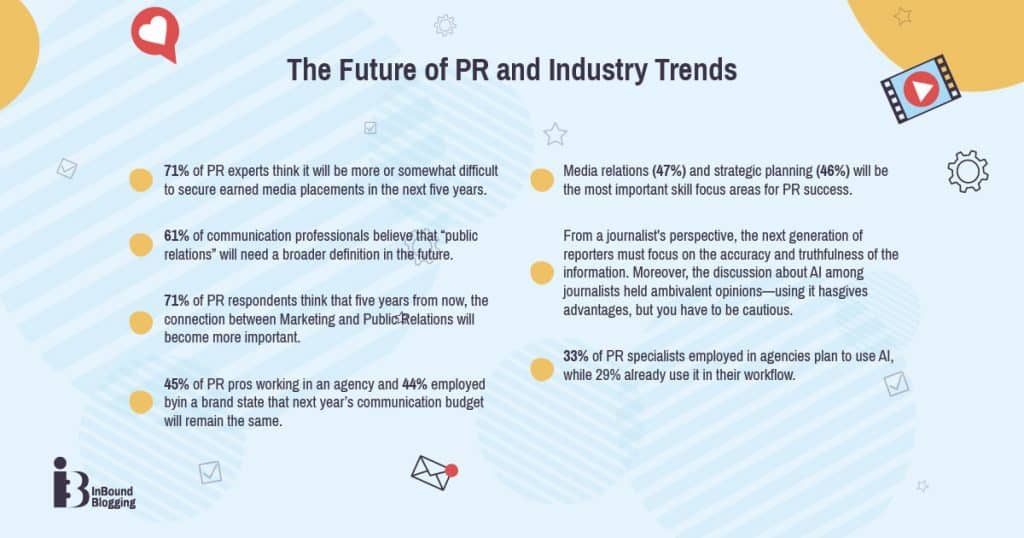
The following public relations statistics highlight the most important future PR trends:
- 71% of PR experts think it will be more or somewhat difficult to secure earned media placements in the next five years.
- 61% of communication professionals believe that “public relations” will need a broader definition in the future.
- 71% of PR respondents think that five years from now the connection between Marketing and Public Relations will become more important.
- 45% of PR pros working in an agency and 44% employed by a brand state that next year’s communication budget will remain the same.
- Media relations (47%) and strategic planning (46%) will be the most important skill focus areas for PR success.
- From a journalist’s perspective, the next generation of reporters must concentrate on the accuracy and truthfulness of the information. Moreover, the discussion about AI among journalists held ambivalent opinions—using it has advantages, but you have to be cautious.
- 33% of PR specialists employed in agencies plan to use AI, while 29% already use it in their workflow.
In the future, AI in PR will be utilized in the following ways:
- Researching and building lists (68%)
- Measuring and monitoring (54%)
- Writing content (52%)
- Reporting (38%)
- Pitching (36%)
- Planning and strategizing (26%)
The top 3 major concerns about using AI in public reactions are:
- Poorly researched AI output leading to lower quality of conversation.
- Younger PR employees won’t learn major professional principles and will rely too much on AI tools.
- Clients thinking that content creators are obsolete.
An interesting fact about public relations is that Google is pitching media outlets about AI technology that will help journalists and editors with news content production.
Final Thoughts
Gone are the days when PR was solely about press releases and media coverage. PR statistics show that the future demands a strategic approach that incorporates data-driven insights to report tangible results to clients. AI tools will make that possible and easier than ever before.
PR professionals have to become more than just communicators. To achieve success, they must also be strategists harnessing the power of data to shape and measure campaigns that resonate with the public.
FAQs
Why is PR important?
PR is important because it helps manage and shape the public’s perception of individuals, organizations, or brands, ultimately influencing their reputation and credibility. It also plays a crucial role in building relationships with stakeholders and securing media coverage, leading to increased visibility and trust.
How can I analyze PR data effectively?
To analyze PR data effectively, you should do the following:
– Define clear objectives
– Select relevant metrics to measure success
– Organize and clean the data
– Apply statistical tests or models where applicable
– Draw meaningful insights from the analysis to inform future strategies
How can digital PR benefit my business?
Digital PR, also known as online PR, uses digital platforms and strategies to enhance a company’s online reputation, reach target audiences, and improve organic search visibility. It helps build brand awareness, increase web traffic, and improve search engine rankings.
How can journalists and influencers contribute to a PR campaign?
Journalists and influencers play a major role in a PR campaign. They can help amplify the company’s message, provide third-party validation, and reach a wider audience. Building relationships with journalists and influencers can lead to media coverage, brand mentions, and increased credibility.
Why should I consider hiring a PR agency?
PR agencies are experts in managing public relations for businesses. They have the knowledge, resources, and industry connections to create effective PR strategies, secure media coverage, and manage crisis situations. Hiring an agency saves time and ensures that your PR efforts are strategic and impactful.
What are some useful tools for PR specialists?
PR specialists can benefit from using tools such as Cision, Muck Rack, Statista, and Prowly. These tools provide valuable media databases, contact information, statistics, and PR campaign management features to streamline efforts and enhance results.
How can PR professionals find new ways to get mentioned in the media?
PR professionals can find new ways to get mentioned in the media by staying updated on industry trends, building relationships with journalists, monitoring media requests and inquiries, and creating compelling and newsworthy content.
How can PRs use statistics in their work?
PRs can use statistics to support their pitches, demonstrate the value of PR efforts, and make data-driven decisions. By leveraging the latest PR statistics, they can better understand trends, adapt their strategies, and measure the effectiveness of their campaigns.
References
- https://www.statista.com/statistics/645836/public-relations-pr-revenue/
- https://www.statista.com/topics/3521/public-relations/
- https://www.statista.com/statistics/185472/estimated-expenses-of-us-public-relations-agencies-since-2005/
- https://www.statista.com/statistics/1274636/fee-income-pr-agencies-us/
- https://blog.businesswire.com/what-to-include-with-your-news-releases-to-get-a-journalists-attention-insights-from-business-wires-2020-media-survey
- https://assets.uscannenberg.org/docs/2019-global-communications-report.pdf
- https://annenberg.usc.edu/sites/default/files/KOS_2017_GCP_April6.pdf
- https://www.zippia.com/public-relations-manager-jobs/demographics/
- https://4272994.fs1.hubspotusercontent-na1.net/hubfs/4272994/The%20State%20of%20AI%20in%20PR%202023/Muck%20Rack%20-%20The%20State%20of%20AI%20in%20PR%202023.pdf
- https://www.pewresearch.org/short-reads/2021/08/30/partisan-divides-in-media-trust-widen-driven-by-a-decline-among-republicans/
- https://www.edelman.com/sites/g/files/aatuss191/files/2021-10/Future%20of%20Corporate%20Communications_FINAL_FULL_REPORT.pdf
- https://www.raise.me/careers/media-and-communication/public-relations-specialists/
- https://www.communicationmonitor.eu/wp-content/uploads/dlm_uploads/ECM2020-Results-ChartVersion.pdf
- https://www.zerto.com/wp-content/uploads/2021/04/IDC-White-Paper-The-State-of-Data-Protection-and-Disaster-Recovery-Readiness-2021.pdf
- https://www.plotlights.com/blog/top-25-pr-statistics-for-2022/
- https://www.statista.com/statistics/1276663/us-cybersecurity-practices-in-place/
- https://www.statista.com/statistics/856505/trust-social-media-companies-user-personal-data-usa/
- https://www.oberlo.com/blog/influencer-marketing-statistics
- https://www.meltwater.com/en/blog/most-important-pr-statistics
- https://www.5wpr.com/new/the-importance-of-data-in-public-relations/
- https://4272994.fs1.hubspotusercontent-na1.net/hubfs/4272994/State%20of%20PR%202023/Muck%20Rack%20-%20State%20of%20PR%202023.pdf
- https://www.statista.com/statistics/183972/estimated-revenue-of-us-public-relations-agencies-since-2000/
- https://www.opensecrets.org/federal-lobbying
- https://www.statista.com/statistics/1394387/areas-investments-pr-firms-worldwide/
- https://www.statista.com/statistics/185518/revenue-sources-of-us-public-relations-agencies-2009/
- https://www.statista.com/statistics/298261/leading-pr-firms-in-the-us-by-net-fees/
- https://www.semrush.com/blog/content-marketing-statistics/
- https://www.provokemedia.com/latest/article/study-most-comms-directors-are-experiencing-content-chaos
- https://www.cision.com/resources/guides-and-reports/2023-state-of-the-media-report/
- https://review42.com/resources/best-day-and-time-to-send-a-press-release/
- https://www.prnewsonline.com/surveys-media-stakeholders/
- https://www.frac.tl/work/marketing-research/publisher-survey/
- https://www.prnewsonline.com/increasing-journalist-pitch-response/
- https://quickmail.io/cold-email/statistics
- https://muckrack.com/blog/2020/05/28/media-pitching-statistics
- https://www.wsiworld.com/our-services/digital-public-relations
- https://4272994.fs1.hubspotusercontent-na1.net/hubfs/4272994/State%20of%20PR%202022/State%20of%20PR%202022_.pdf
- https://www.statista.com/statistics/1387589/market-value-pr-tools-worldwide/
- https://www.statista.com/statistics/1387593/share-market-value-pr-tools-country-worldwide/
- https://www.statista.com/statistics/299878/change-in-employment-for-public-relations-specialists/
- https://www.nielsen.com/insights/2021/beyond-martech-building-trust-with-consumers-and-engaging-where-sentiment-is-high/



